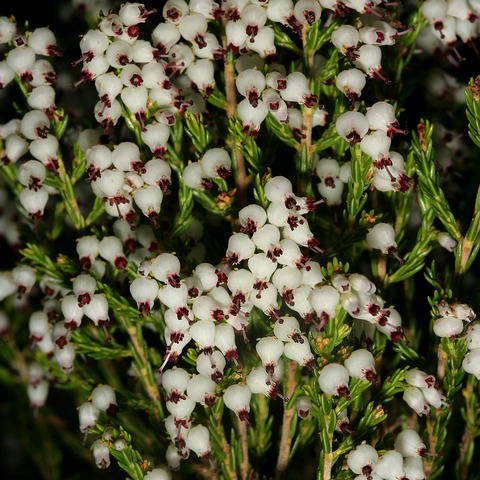Erect shrub, mostly about 60 cm (2 ft) high, occasionally up to 1.8 m (6 ft). Branches erect or spreading, pallid, puberulous. Leaves 2-4 mm long, 3-to 4-nate, often varying on the same plant, mostly erect and imbricate, or sometimes shorter than the internodes, more rarely spreading, linear, semiterete, sulcate, glabrous, pallid. Flowers terminal, 3-to 6-nate; peduncles 2-4 mm long, straight or decurved, puberulous; bracts median, linear, small. Sepals 1-1.5 mm long, ovate to lanceolate, keel-tipped, acute or obtuse, ciliate, subscarious or subfoliaceous, mostly glabrous, sometimes pubescent. Corolla 2.5-4 mm long, suburceolate-cyathiform, not, or very slightly, constricted at the throat, glabrous, white; lobes about 1/3 the length of the tube, erect, broad, sometimes irregularly toothed. Anthers subexserted, rarely exserted, 0.8-1 mm long, sublateral, obliquely oblong or narrow-elliptical, sparsely ciliate on the front margins, appendiculate; pore about 1/2 the length of the cell; awns 1/2-2/3 the length of the cell, curved, subulate, acuminate, ciliate. Ovary turbinate, glabrous; style exserted, sometimes decurved; stigma peltate-capitate.
More
Erect to spreading-erect, much-branched shrub, 0.3-0.6(-2.0) m high. Branches woody; bark rough, dark grey, flaking, new growth softly hairy. Leaves 3-or 4-nate; erect, overlapping; blade needle-like, 2-4 mm long, glabrous. Flowers: 3-or 4-6-nate; pedicels 2-4 mm long, straight or decurved, puberulous; bracts 3, linear, remote; anthers subexserted, rarely exserted, with aristate awns, filaments straight and slender; ovary glabrous, style prominently exserted, sometimes decurved; stigma peltate-capitate; calyx ± 1/3 length of corolla, ovate to narrowly ovate, 1.0-1.5 mm long, keel-tipped, usually glabrous; corolla urn-, bell-or cup-shaped, slightly or not constricted at throat, 2.5-4.5 mm long, glabrous, white or brown; Jan.-Dec.
Shrub, up to 1.5 m high. Leaves 3-or 4-nate, linear, semiterete. Flowers 3-or 4-6-nate, terminal. Corolla suburceolate-cyathiform, glabrous. Anthers subex-serted, rarely exserted. Style exserted. Flowers white.

